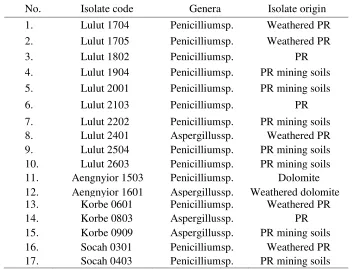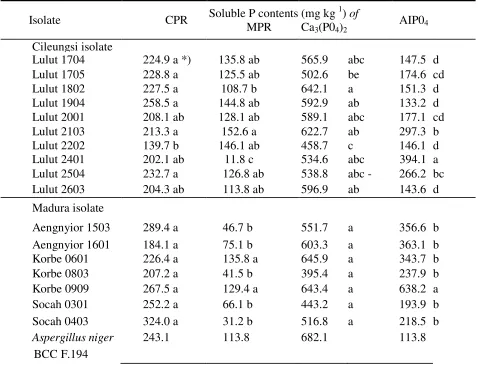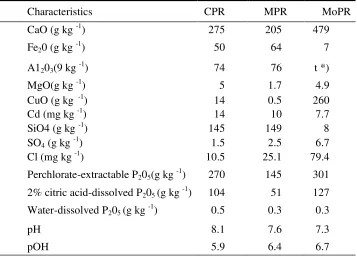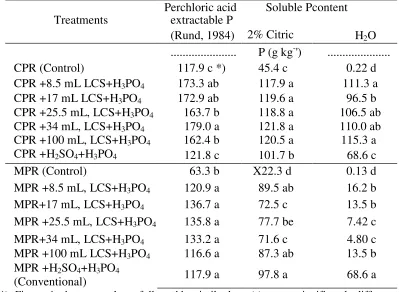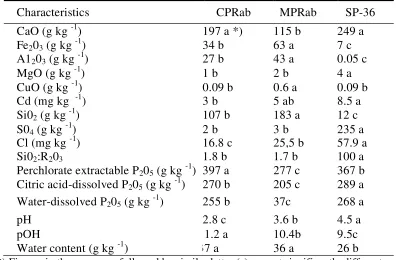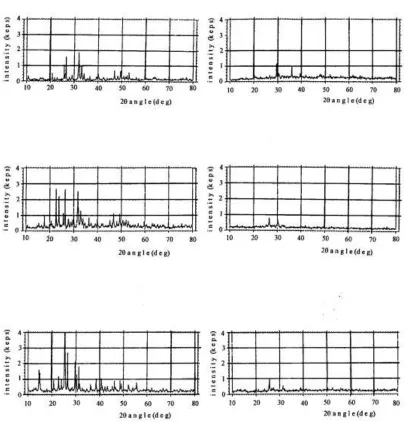Menara Perkebunan, 2000, 68 (1), 39 – 52
Bioactivation of phosphate rocks by indigenous
phosphate-solubilizing fungi
Bioaktivasi fosfat alam oleh fungi pelarut fosfat setempat
H. WIDIASTUTI'), Didiek H. GOENADI'), T. PANJI'), L.P. SANTI'), P. FATURACHIM'), N. MARDIANA'), 1. HARIANTO 2),ISROI3) 1)
Biotechnology Research Unit for Estate Crops, Bogor 16151, Indonesia
2
PT. Pupuk Kalimantan Timur
3)
Jenderal Sudirman University, Purwokerto
Ringkasan
Summary
The effectiveness of phosphate-solubilizing fungi (PSF) in enhancing phosphorus (P) solubility of phosphate rocks (PR) is assumed to be dependent on the suitability of the fungal isolate to the mineralogycal composition of the rocks. A laboratory study was conducted to determine the phosphate solubilizing ability of liquid culture supernatants (LCS) of PSF isolated from various PR deposits and adjacent soils, i.e. at Cileungsi in West Java and the island of Madura in East Java to enhance the reactivity of PR from deposits at Cileungsi (CPR) and Madura (MPR) and their potential use as agents in the production of bio -logically-activated superphosphate (SPab). Three series of laboratory experiments were conducted: (1) screening isolate on the solubilization of P in Pikovskaya medium; (2) assaying the ability of selected isolates on solubilization of P-CPR, PMPR, P-Ca3(P04)2 and P-AIPO4, and (3) optimizing superphosphate fertilizer formulation. Completely random design was used as the experimental design with two replicates. Seventeen out of 50 PSF isolates were characterized to be highly potential as phosphate solubilizers, as indicated by clear zone formation. Ten isolates were from Lulut (Cileungsi) and seven from Madura island, two from Socah and Aengnyior respectively, and remaining three from Korbe. Regarding the ability of P solubilization of four P sources, six isolates were selected, t hree each from Cileungsi and Madura. Of these six isolates, four are Penicillium sp., and four belong to Aspergillus sp. The Aspergillus sp. isolate Korbe 0909 was found to be the highest in P-solubilization of various sources of P. Based on the P dissolving ability of P-CPR and their effectiveness in substituting for sulphuric acid (98%) usually used in conventional production of superphosphate, the LCS of Korbe 0909 improved significantly the P-PRs dissolution. MPR activated by the LCS yielded a comparable values of 2% citric acid-soluble P content and significantly lower water-acid-soluble P compared with conventional method: Reduction of phosphoric acid (H3PO4) concentration from 52% to 42%, in combination with LCS treatment, produced P dissolution comparable to the conventional method. Although the P solubilization of CSPab and MsPab in both 2% citric acid and water as well as thus content were significantly lower compared with SP36.
[Key words: Phosphate-solubilizing fungi, rocks phosphate, biological activation]
Introduction
Local PR is known to be of low quality as indicated by low phosphate solubility in water and citric acid. The reactivity of phosphate rocks (PR) has been improved for instance by refining the granule's size and acidification with ammonium sulfate (Goenadi, 1994), H2SO4, and/or H3PO4 (Goenadi, 1990; Rajan & Ghani, 1997). However, this activation process is expensive and not environmentally safe, although its agronomic effect has been proven to be positive. This is the reason why further efforts are carried out to formulate the most effective and environmentally safe activated PR products.
with a low solubility in citric acid (< 8%) and water (<0.01%) can be improved. The efficacy of selected Pseudomonas species in dissolving PR from suspension, agar, and soil has received considerable attention in the last two decades. Bar-Yosef et al. (1999) confirmed that gluconic and 2ketogluconic' acids produced by P. cepacia increased the orthophosphate concentration in solution.
The ability of phosphate-solubilizing fungi (PSF) to dissolve relatively insoluble P has been utilized to increase the availability of P in the soil. The solubility of pho sphorus is much influenced by the suitability of isolates with the PR mineralogy. However, Goenadi et al. (2000) showed that the direct use of microbes in PR bioactivation was less efficient than the use of liquid culture supernatant (LCS) of these microbes. The result of above mentioned research indicated that citric acid was the dominant P-PR solubilizing compound from Morroco.
Citric acid is highly potential in chelating metal, so that it can be used to activate PR. Theoritically, microbes with the ability to produce citric acid can also dissolve P-PR. The optimum condition to produce citric acid by new superior isolates from the local PR mines still needs further investigation. This paper presents results of laboratory studies with the objectives of : (1) screening isolates on the solubilization of P in Pikovskaya medium, (2) assaying the Isolation was performed by using in Pikovskaya medium (Rao, 1982).
Assessment of the phosphate solubilizing ability of four P sources by PSF
Construction of SPab prototype
Prototype SPab was constructed by determining first the optimum LCS volume of the selected isolate (Korbe 0909) for the bioactivation process. The' LCS volume tested was 0, 8.5, 17, 25.5, 34, and 100mL which was then put into 55 g CPR and MPR. The organic acid was analyzed with a high performance layer chromatography (HPLC). In order to enhance the P-PR dissolution 28mL of H3PO4 (52%) was added. The PR activation process was carried out for two hours and for comparison the PR activation was performed conventionally with the addition of 17mL H2SO4 (98%) and 28mL H3PO4 (52%). The following step was to determine the effect of decreasing the H3PO4 concentration (42%, 32% and 22%, (v/v)) on the Perchlorate-extractable P, 2% citric acidsoluble P and water-soluble P contents. Analysis was carried out on P solubility in citric acid and water. The trial was conducted by a completely random design with two replicates. For the production of granular SPab water was used as a granulating agent. The mineralogical characteristics of the SPab prototype was observed using scanning electron microscopy (SEM) and X-ray diffraction (XRD) analyses.
Results and Discussion
Phosphate-solubilizing fungal (PSF) isolates
Fifty isolates were obtained from soil samples, PR, and dolomite, respectively 20 from Cileungsi and 30 from Madura. From these isolates, 17 were able to form an intensive clear zone indicating their ability to dissolve PR. Of these 17 selected isolates, 10 were from Lulut, two from Aengnyior, three from Korbe and two from Socah (Table 1). Seven of the 17 (1999) showed that the genus Aspergillus and Penicillium have a high potential in dissolving phosphate. According to Rao (1982) and Cunningham & Kuiack (1992) the mechanism of dissolving phosphate by the two mentioned genera is by producing organic acids such as formic, acetic, propionic, lactic, fumaric, succinic, citric and oxalic acids. The organic acids are assumed to form chelates with ion Ca 2+, Mgt+, Fe'+ and Al'+ so the phosphate will be released.
P-dissolving capacity of selected PSF isolates
mechanismof dissolving P from inorganic sources like PR by various fungi is by producing organic acid which causes a reaction tending to become acid which promotes rock dissolution. However, various fungi produce different dominant organic acids which can influence the extent of P solubility.
Besides, the P source influences the ability of the isolate to dissolve P. According to Illmer & Schinner (1992), the difference in capability of dissolving P from different sources is caused by the difference in structure and strength of the bound phosphorus of that source. In general, the Lulut isolate 2103 has the highest capacity to dissolve P from the four sources investigated. This isolate belongs to Penicillium sp. and originating from PR, in which the P of PR might induce P dissolution capability to the fungus.
The seven isolates from Madura were able to dissolve P in the form of CPR-P and Ca3(PO4)2, which was not really different between the isolates (Table 2), whereas the capacity of the respective isolates differs in dissolving P from MPR and AIP04. The isolate Korbe 0909 can dissolve the highest level P of MPR and AIP04 compared to the other isolates. The isolate Korbe 0909 is derived from PR mining soil. Similar result were obtained from isolates of Madura, where the high content of P can trigger the isolate Korbe to dissolve P. According to Goenadi et al. (1999) dissolution of inorganic P through organic acid production was triggered by the low P content. This result shows that there might be a difference in mechanism of dissolving P between Lulut 2103 and Korbe 0909 with the isolate PSF used by Goenadi et al. (1999). However this evidence needs to be further examined.
Table 1. Genera and the origin of selected phosphate-solubilizing fungal (PSF) isolates
Table 2. Soluble P contents of CPR, MPR, Ca3(P04)2 and AIP04 treated with selected phosphate-solubilizing fungi (PSF) biomass isolated from Cileungsi and Madura
Isolate CPR Soluble P contents
*) Figures in the same column followed by similar letter(s) are not significantly different according to DMRT(P<0.05)
It is evident that the isolate from Madura (Korbe 0909) has a better ability to dissolve P -PR from Cileungsi compared to the isolate from Cileungsi (Lulut 2103), and in contrast the isolate from Cileungsi (Lulut 2103) has a higher ability to dissolve P-PR from Madura than the isolate from Madura (Korbe 0909). This result shows that the indigenous isolate does not always have a higher ability in dissolving P from its original rock if compared with the introduced isolates.
The superior isolates Korbe 0909 and Lulut 2103 have comparable capacity as the standard isolate A. niger BCC F.194 in dissolving P, but higher dissolving Al-P. The highly potential isolates for dissolving Al-P obtained in this research opens the possibility to use these isolates as biofertilizers in improving the availability of P in soils with a high content of AI.
(1997) namely the time of citric acid production by PSF used in this experiment has a similarity with the isolate used by Sakurai et al. (1997). In isolate Korbe 0909 and Lulut 2103, an accumulation of P occurs at its highest on the ninth day. Therefore, in the following experiment the incubation Was carried out in nine days for an optimum period for dissolving P.
Chemical properties of PR
The results show that there were differences between the chemical composition of CPR, MPR and PR ex-Morroco (a conventional PR raw material for commercial SP). Among the three PR sources, P205 content of CPR (dissolved in perchloric acid, 2% citric acid, and water) was equal to PR ex-Morroco (MoPR), while the P content of MPR was lower (Table 3). The potential elements binding phosphorus are Ca, Fe and Al. It was shown that the CaO content of MoPR was higher than that of CPR and MPR. Nevertheless, among the analyzed elements, Ca contents in CPR and MPR were relatively high. Besides, Fe203 and A1203 contents of CPR and MPR were much higher than those of MoPR. These results indicate that P contained in MoPR is available to plant in the form bound by Ca, while P contained in CPR and MPR, besides bound by Ca, is also bound by Fe and Al. The tight bound of P by Ca, Fe and AI causes dissolved P205 in water is low.
In the P dissolution process, P bound by Ca, Fe and A1 should be released. The Al-P binding was assumed more dominant in MPR than in CPR because it contained lower perchlorate ,extractable P205 in comparison with CPR, while the A1203 contents were almost the same. The high Al contents in these two PR sources need attention if these PR will be applied on acid soils which commonly have a high Al content
Table 3. Chemical characteristics of CPR, MPR and Morrocan phosphate rock (MoPR)
Construction of SPab prototype
The addition of LCS from a 9-day-old culture of Korbe 0909 isolate as much as 8.5 - 100 mL, into CPR increased significantly P dissolving of CPR origin in perchloric acid, 2% citric acid, and water (Table 4). LCS at the volume of 8.5 mL was sufficient to produce high dissolved P. If compared with PR dissolution using conventional method (HZ S04 and H3PO4), LCS at CPR produced significantly higher dissolving P (perchloric acid, 2% citric acid and water). This result shows that LCS was able to dissolve P in PR source and to replace H2SO4 function in dissolving P.
The LCS addition to MPR significantly increased solubility of P compared to the un-treated one (control). Among tested LCS volumes, the volume of 8.5 mL, was sufficient to dissolve P-MPR. Therefore, based on production efficiency, application of 8.5 mL LCS as activating solution is considered to be sufficient. Nevertheless, LCS' produced P dissolving (perchloric and citric acid) was not significantly different with conventional method, while P dissolving in water was significantly lower than using conventional method. These results showed that LCS could dissolve phosphorus in MPR, however, the potency of phosphorus dissolving was lower in comparison with H2SO4. The result showed that probably there was organic acid in LCS enable to dissolve P-PR, nevertheless, because of differences of phosphorus bound in MPR and CPR, the soluble P total of the two P sources was also different, as stated by Illmer & Schinner (1995).
Table 4. Soluble P contents of CPR and MPR pretreated with various volume of a 9-day- old culture of Korbe 0909 LCS and H3PO4 (52%) in comparison with conventional method.
The results show that P content of SPab of Cileungsi (dissolved in perchloric acid, 2% citric acid and water) was higher than that of Madura (Table 5). The high solubility of citrate and water shows that LCS has the potencial in activating CPR. As stated previously most of the phosphorus in CPR was probably fixed by Ca, and the present result indicate that LCS could apparently release P from the Ca binding. On the contrary, the Fe203 and A1203 contents of SPab of Madura. were significantly higher than SPab of Cileungsi. Probably, the low P solubility (2% citric acid and water) of SPab of Madura was due to the high Fe203 and A1203 or probably there was an unsuitable isolate strain used to produce LCS. Other possibility that should be considered is that the LCS was not capable enough to dissolve phosphorus fixed by Fe and Al. Besides, the SiO2,contents in CPR and MPR were higher than that in SP36. The low SiO2/R203 (sesquioxide) ratio has a higher capacity to bind phosphorus than the high Si02/R203 ratio (Tan, 1995). This phenomenon also could explain the low solubility of P-SPab of Cileungsi and P-SPab of Madura in water and 2% citric acid in comparison with that of SP36.
The enhancement of PR reactivity is aimed at increasing the P solubility value in 2% citric acid near to the total P value and the value of water-dissolved P near to the value of 2% citric acid-dissolved P (Goenadi, 1996). In this research, P205 dissolved in water and citric acid of CPRab and MPRab was higher than P205 content dissolved in water and 2% citric acid of CPR and MPR and these respective values were close to P205 value dissolved in 2% citric and perchloric acid. Based on these results, the aim at enhancing PR reactivity could be
Table 5. Chemical characteristics of biologically activated CPR (CPRab) and MPR (MPRab) in comparison with SP36
achieved biologically. However, there were still differences between total P205 value with citric acid P205 and citric acid P205 with water P205, so there are still other techniques needed to increase the reactivities of CPR and MPR.
The analysis of LCS organic acid using HPLC showed that in LCS, derived from Korbe 0909 isolate grown in Pikovskaya liquid medium without phosphorous, there were 1334 mg kg' oxalic, 326 mg kg-1 citric, 263 mg kg-1 gluconic and 131 mg kg-1 glycolic acids. These results showed that the dominant organic acid in LCS was oxalic acid. According to Goenadi et al. (2000), citric acid has a higher potential to increase reactivity of CPR and MPR than oxalic acid. Therefore, reactivity of CPR and MPR probably still can be enhanced through the induction of citric acid production of Korbe 0909 isolate, for instance by manipulating its metabolism.
To determine the impact of treatments on the condition of crystal minerals, observation was performed by SEM and XRD analyses on the SPab prototypes. The result showed that there were changes in physical form and material component between untreated PR and PR activated biologically and conventionally (Figure 1). The XRD analysis showed that the dissolution of LCS and acids (H2SO4 and H3PO4) caused damage to mineral crystal (Figure 2). The XR diffrac tograms show that CPR and MPR were dominated by phosphatic mineral, i.e. apatite (Ca3(PO4)3(F, OH, Cl)). This is in accordance with the referenced characteristics of the mineral stated by Brindley & Brown (1980).
The result of dissolved P analysis showed that in CPR the decrease of H3PO4 concentration affected the perchloric acid extractable, 2% citric acid and water-dissolved P (Table 6). The effect of reduction of H3PO4 concentration on water-dissolved P was apparently larger in comparison with 2% citric acid and perchloric acid-dissolved P. In these PR, utilization of 42% H3PO4 produced citrate and perchlorate-extractable P which was not significantly different with utilization of 52% H3PO4.
Table 6. Soluble P contents of CPRab and MPRab as affected by reduction of phosphoric acid concentration.
Perchloric acid Soluble P content
Treatments extractable P 2% Citric
(Rund, 1984) acid HZO
... P (g kg -1) ... .... CPR+8.5 mL LCS+28 mL H3PO4 (52%) 173.3 a*) 117.9 a 111.3 a
CPR+8.5 mL LCS+28 mL H3PO4 (42%) 154.1 ab 112.7 a 89.5 b
89.5 b CPR+8.5 mL LCS+28 mL H3PO4 (32%) 140.2 ab 91.3 b
.
71.6 c CPR+8.5 mL LCS+28 mL H3PO4 (22%) 134.9 b 72.5 c 63.8 d
MPR+8.5 mL LCS+28 mL H3PO4 (52%) 140.0 a 75.1 a 22.3 a
MPR+8.5 mL LCS+28 mL H3PO4 (42%) 134.0 a 72.5 a 21.4 a
MPR+8.5 mL LCS+28 mL H3PO4 (32%) 114.8 b 52.0 b 21.0 a
MPR+8.5 mL LCS+28 mL H3PO4 (22%) 95.6 c 51.1 b 14.4 b
*) Figures followed by similar letter(s),in the same column and in the same PR source are not significantly different according to DMRT (P < 0.05).
Conclusions and Suggestions
The reactivity of PR from Cileungsi (CPR) and Madura (MPR) could be increased by using LCS from Korbe 0909 isolate which was isolated from PR mining soil and identified as Aspergillus sp. The ability of Korbe 0909 isolate to dissolve P was significantly higher than conventional method in CPR, while it was not significantly different in MPR. However, dissolved P (2% citric acid and water) and the S contents of activated CPR and MPR were significantly lower than those of SP36.
Utilization of other technologies to activate CPR and MPR can be done in order to make P content dissolved in citric acid equal to P dissolved in perchloric acid as well as to make P dissolved in water equal to P dissolved in citric acid. In addition concerning the high Al content in CPR and MPR, apparently researches to study the potential of Al toxicity in CPR and MPR on plant growth or the effort to reduce or neutralize Al in CPR and MPR need to be done.
Acknowledgements
References
Bar-Yosef, B., R. D. Rogers, J. H. Wolfram, & E. Richman (1999). Pseudomonas cepacia mediated rock phosphate solubilization in Kaolinite and Montmorillonit suspensions. Soil Sci. Soc. Am. J., 63, 1703-1708.
Bojinova, D., R. Velkova, 1. Grancharov & S. Zhelev (1997). The bioconversion of Tunisian phosphorite using Aspergillus niger. Nut. Cyc. Agroecosyst., 47(3), 227-232.
Brindley, G. W. & G. Brown (1980). Crystal structures of clay minerals and their X-ray identification. Mineralogical Soc. Monograph No. 5 London, UK.
Cunningham, J.E. & C. Kuiack (1992). Productions of citric and oxalic acids and solubil-izations of calcium phosphate by Penicillium bilaji. Appl. Environ. Microbiol., 58(5), 1452-1458.
Domsch, K.H., W. Gams & T.H. Anderson (1980). Compedium of Soil Fungi. London, Aca-demic Press
Gilman, J.C. (1963). A Manual of Soil Fungi. Amas, The Iowa State University Press, 450pp.
Goenadi, D.H. (1990). Effect of acidulation on the mineralogical characteristics of a commer-cial phosphate rock. Indon. J. Trop. Agric., 2,1-5.
Goenadi, D.H. & R. Saraswati (1993). Kemampuan melarutkan fosfat dari beberapa isolat fungi pelarut fosfat. Menara Perkebunan, 61 (3), 61-66.
Goenadi, D.H. (1994). Reaktivita§ pupuk fosfat alam yang digranulasi dengan amonium sulfat dan yang diasamkan sebagian. Pelita Perkebunan, 10(2), 73-80.
Goenadi, D.H. (1996). Pemanfaatan mikroba pelarut fosfat dalam pembuatan pupuk Bio-P. Warta Puslit. Biotek Perkebunan, 11(1), 4348.
Goenadi, D.H., R.A. Pasaribu, Isroi, H. Hartono & R. Misman (1999). Phosphate-solubilizing fungi isolated from tropical forest soils. Menara Perkebunan, 67(1), 40-51.
Goenadi, D.H., Siswanto & Y. Sugiarto (2000). Bioactivation of poorly soluble phosphate rocks with a P solubilizing fungus. Soil. Sci. Soc.Am.J., 64,927-932.
lilmer, P. & F. Schinner (1992). Solubilization of inorganic phosphate by microorganisms isolated from forest soils. Soil Biol. Biochem., 24, 389-395.
Illmer, P., A. Barbato & F. Schinner (1995). Solubilization of hardly-soluble AIP04 with.. P-solubilizing microorganisms. Soil Biol. Biochem., 23(3),265-270.
Omar, S.A. (1998). The role of rock-phosphatesolubilizing fungi and vesicular-arbuscular-mycorrhiza (VAM) in growth of wheat plants fertilized with rock phosphate. World J. Microbiol. Biotechnol., 14(2), 211-218.
Premono, M.E., R. Widyastuti & I. A. Chaniago (1992). Pengaruh bakteri pelarut fosfat terhadap serapan kation unsur mikro tanaman jagung pada tanah masam. Dalam Pertemuan Ilmiah Tahunan PERMI Bogor, 2-3 Desember 1991.
Rajan, S.S.S. & A. Ghani (1997). Differential influence of soil -pH on the availability of partially sulphuric and phosphoric acidulated phosphate rocks. 2. Chemical and scanning electron microscopic studies. Nutr. Cyc. Agroecosyst., 48 (3), 171-178.
Rao, N.S.S. (1982). Phosphate solubilizing microorganisms. In Biofertilizer in Agriculture. New Delhi, Oxford & IBH Publishing Co.
Rund, R. C. (1984). Agricultural limiting materials In Sidney Williams (Ed.) Official Methods of Analysis of the Association of Official Analytical Chemists. Virginia, USA. p 1-7 Sakurai, A., M. Itoh, M. Sakakibara, H. Saito & M. Fujita (1997). Citric acid production by
Aspergillus niger immobilized on porous cellulose beads. J. Citric Technol. Biotech., 70,157-162.
Samson, R.A., E.S. Hoekstra & C.A.N van Oorschot (1984). Introduction to Food Borne Fungi. Centraalbureau voor Schimmelcultures. BAARN, Netherlands.
Tan, K.H. (1995). Dasar-dasar Kimia Tanah (terjemahan). Jogyakarta, Gadjah Mada University Press. 295pp.
